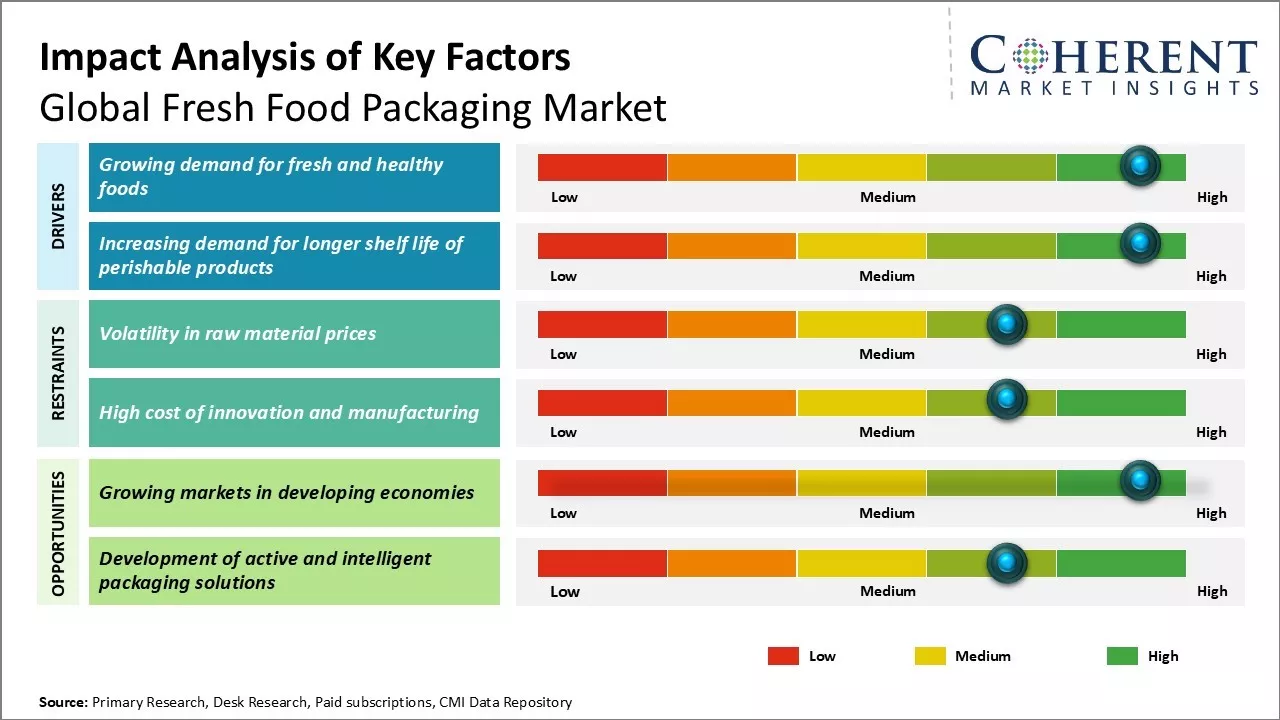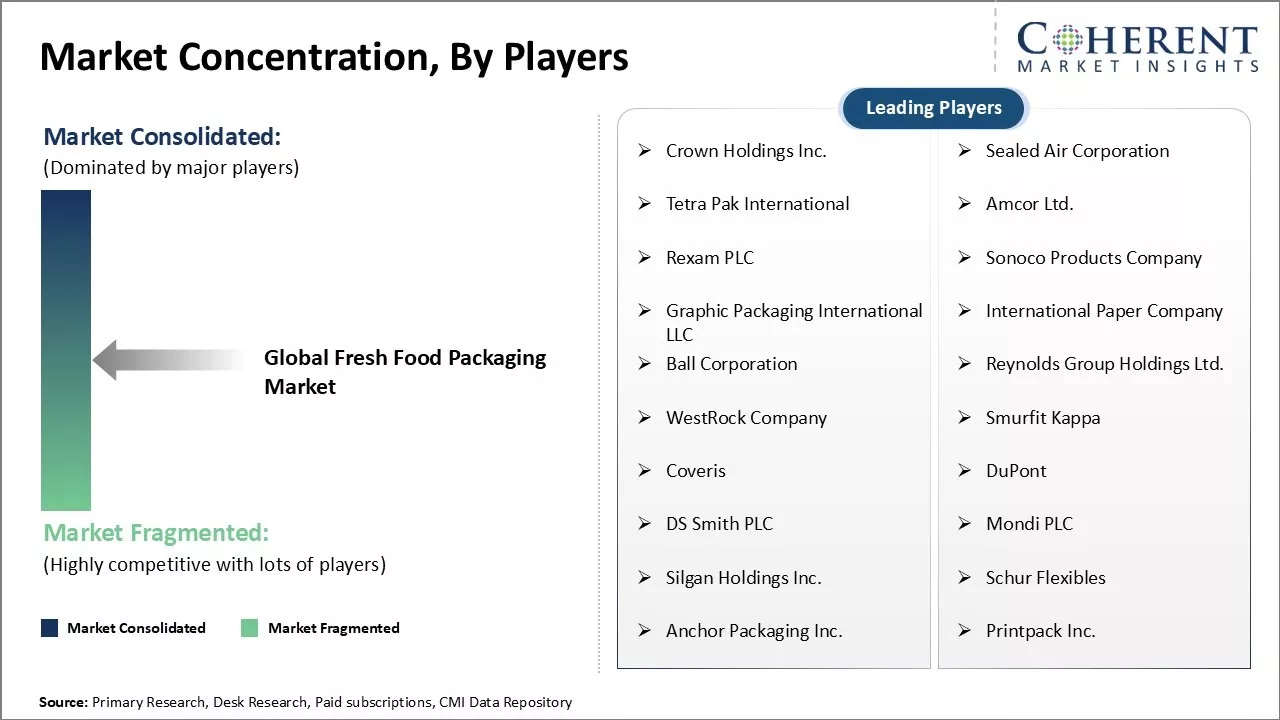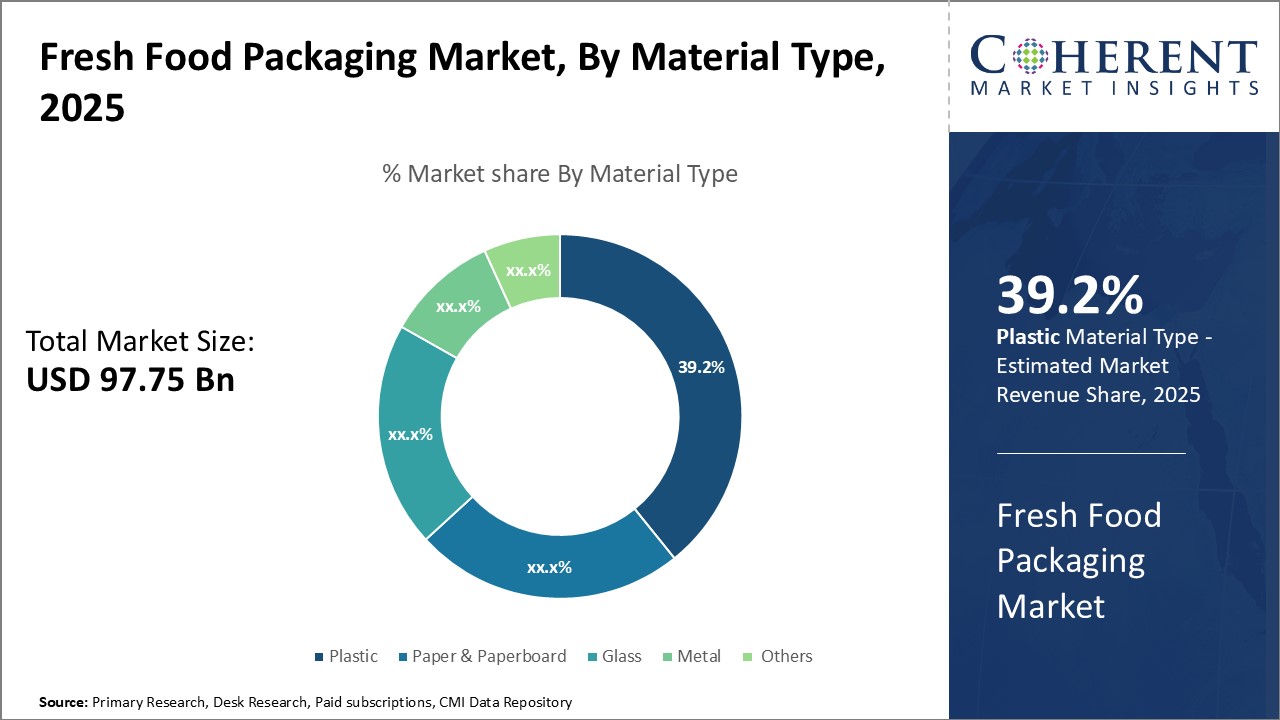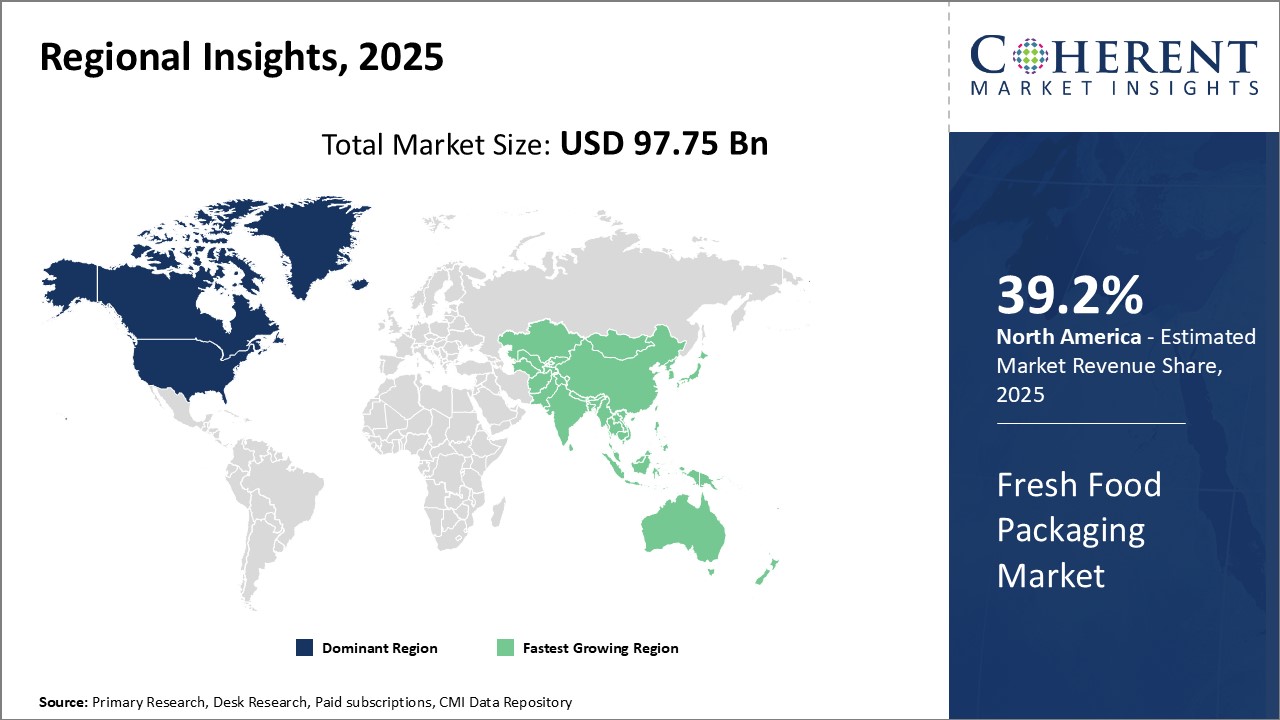The Global Fresh Food Packaging Market is estimated to be valued at USD 97.75 Bn in 2025 and is expected to reach USD 131.34 Bn by 2032, exhibiting a compound annual growth rate (CAGR) of 4.3% from 2025 to 2032.

Discover market dynamics shaping the industry: Request sample copy
The market has seen steady growth over the past few years driven by rising consumer demand for fresh and high-quality food products.
Growing demand for fresh and healthy foods
As consumers are becoming more health conscious in today's fast paced life, they are preferring to include fresh and healthy foods in their diet. There is a growing realization that fresh foods packed with all the essential nutrients are better for maintaining overall health and wellness. People want foods that are not only tasty but also offer nourishment to keep them energetic throughout the day. With increasing awareness about benefits of fruits and vegetables, more households are adopting diets rich in these items on a daily basis.
To reliably supply fresh produce to people, efficient packaging solutions are required which can facilitate easy transportation from farms to retailers while protecting quality. Packaging technologies that increase accessibility of fresh foods will see higher adoption rates. For instance, pre-cut vegetables or fruits packaged innovatively for single or multiple servings based on household size can inspire more consumption. Technologies preserving nutrients for longer through minimal processing are drawing interest from health-oriented consumers. Meeting multifaceted packaging needs of perishable foods will become an area of focus.
Demand for fresh prepared meals is rising across fast casual restaurants and takeaways catering to busy lifestyles. Here too, sustainable packaging performing critical functions like indicating freshness, absorbing moisture and preventing cross-contamination plays a key role. As environmental and social responsibilities increase, compostable or recyclable fresh food packaging will gain prominence. Innovation supporting supply chain visibility can aid market growth by improving trust in safety and origins of products.

Get actionable strategies to beat competition: Request sample copy
Increasing demand for longer shelf life of perishable products
Shelf-life extension is one of the primary packaging objectives for fresh produce including meat, seafood, dairy, etc. Due to long distance transportation involved and changing consumption patterns, minimizing post-harvest loss of perishables before reaching consumers has become imperative.
To overcome logistic challenges and reduce food wastage, packaging manufacturers are focused on leveraging active and intelligent solutions. Active packaging infused with antimicrobials and atmosphere control helps retain freshness attributes like texture, flavor, and nutrients for extended period. Traditionally used for high value goods like berries and seafood, active technologies are percolating to mass market categories as well. Advances in material science facilitate the development of affordable options suited for different climatic conditions and distribution networks.
Intelligent indicators like time temperature indicators immediately reveal if safety temperature has been breached during transit avoiding consumption of compromised food. Similarly, freshness indicators change color after a preset number of days from packaging to inform consumers. As internet of things gets integrated into supply chains, connected and autonomous packaging monitoring atmospheric conditions, vibrations, and opening-closing events promises real time insight on condition and location of shipments. This will enhance predictability and quality consistency in the supply chain.
The demand for innovative active and intelligent packaging from food industry and retailers is growing rapidly to meet rising expectations around sustainability and food safety. Manufacturers serving global fresh food packaging landscape need robust insights into evolving technical, regulatory and consumer requirements to develop solutions maximizing value for all stakeholders.
Key Takeaways from Analyst:
The global fresh food packaging market is poised to grow significantly in the coming years driven by growing health consciousness among consumers along with rising disposable incomes. This will propel the need for innovative packaging solutions that can help extend the shelf life of perishable products and maintain food quality. Some of the key growth regions include North America and Asia Pacific with increasing popularity of online grocery shopping and demand for convenient packaging.
However, stringent regulations around plastic packaging and single-use plastics pose a challenge. Regulations are expected to become more stringent to curb pollution. This may restrict the use of certain materials. High commodity and raw material prices also impact packaging costs, posing a restraint. Developing biodegradable and environment-friendly packaging alternatives from renewable resources can help tackle legislative and sustainability issues while capturing new opportunities.
Adoption of active and intelligent packaging incorporating smart indicators and sensors is expected to rise for temperature control, freshness monitoring, and ensuring supply chain integrity. Advancements in modified atmosphere packaging and aseptic packaging technologies will expand application in food types. Growing e-commerce is also opening opportunities for ship-to-home packaging formats. Overall, innovations focused on extending shelf-life, quality retention, supply chain transparency, and sustainability will drive growth in the fresh food packaging industry globally.
Market Challenges: Volatility in raw material prices
One of the key challenges faced by the global fresh food packaging market is the volatility in raw material prices. As fresh food packaging extensively relies on plastics as a raw material for packaging products such as plastic bags, trays, wraps, etc., fluctuations in global oil and petrochemical prices have a significant impact on plastic raw material costs. In the recent past, rising crude oil prices have increased the prices of plastic resins and polymers. This has increased production costs for fresh food packaging manufacturers. Passing on the entire cost increase to customers is also not feasible and affects profit margins. Unpredictable commodity price swings make it challenging to establish stable pricing for packaging products. The coronavirus pandemic has further exacerbated fluctuations in raw material costs. Fresh food packaging companies need to closely monitor raw material price movements and effectively manage procurement to minimize risks arising out of supply chain disruptions. Adopting efficient material selection and rigorous cost control measures are important to sustain profitability during volatile market conditions.
Market Opportunities: Growing markets in developing economies
One of the key opportunities for the global fresh food packaging market is the rapidly growing markets in developing economies. With rising disposable incomes and growth in spending power, fresh food consumption is increasing steadily in developing Asian, Latin American, Middle Eastern, and African markets. However, in many developing nations, a large portion of the agricultural produce is still distributed without proper packaging. This leaves significant room for growth of organized retail and utilization of protective fresh food packaging. Introduction of innovative yet affordable packaging solutions tailored to the requirements of local producers and consumers can help drive wider adoption. The development of cold chain infrastructure will further aid market expansion. Foreign and local fresh food packaging manufacturers need to focus on these emerging markets by establishing distribution networks and customizing products as per regional demands. Strategically tapping rising demand can ensure profitable long-term returns.

Discover high revenue pocket segments and roadmap to it: Request sample copy
Insights by Material Type: Adaptability and Versatility Drive Plastic's Dominance
In terms of material type, the plastic segment is estimated to dominate the market revenue share with 39.2% in 2025, owing to its adaptability and versatility across various packaging needs. Plastic offers packages protection from damage during transportation while also preventing contamination and deterioration. Its lightweight and high strength characteristics make it cost-effective to use for multi-national brands.
Plastic gives packagers flexibility in design and functionality. Packages can be made leak-proof, airtight or permeable depending on product requirements. Features like pouring spouts, zippers, and tamper-proof seals increase usability. Films, sheets, bottles and containers with varying thicknesses allow tailored protection for diverse produce. Thermoforming plastic into complex shapes accommodates irregular foods and maximizes load space in shipping.
Being translucent or transparent, plastic displays products attractively. Vibrant prints and images on plastic catch consumer attention on shelves. Anti-fog properties maintain visual appeal under different temperatures. Plastic is compatible with filling and sealing automation for high production volumes. Its moldability means designs can evolve as market trends change quickly. Overall plastic's customizability according to evolving needs of food business and customers has made it the go-to packaging choice.
Insights by Packaging Type: Flexibility and Barrier Properties Drive Flexible Packaging Dominance
In terms of packaging type, the flexible packaging segment is estimated to contribute 33% share to the market in 2025, owing to its flexibility and enhanced barrier properties. Flexible formats conform to any product shape without additional processing or material wastage. Produce, snacks and easy to handle meals are ideal applications.
Multi-layer flexible films offer high moisture, gas and grease resistance protecting quality during shelf-life. Proportions of plastic, aluminum and adhesives can be tailored for ideal barrier against air and external elements. Products across various perishability levels find suited home. Materials augment shelf-life from days to over a month.
Reclosability, stand-up pouches and other features provide convenience during usage. Recyclable laminates enable downgauging without compromising strength or functionality. Lightweight flexible packaging in turn uses fewer resources to transport the equivalent load. Overall flexibility to achieve optimized protection with minimal material usage at reduced cost has boosted the uptake of flexible solutions industry-wide.
Insights by Application: Protection Needs Drive Eggs, Meat and Seafood Dominance
In terms of application, the eggs, meat and seafood segment is estimated to contribute 32.7% share to the market in 2025, owing to the high protection needs of these perishable products. Strong barriers against moisture, oxygen and grease are essential to maintain quality and prevent spoilage during shelf life ranging from a few days to weeks.
Rigid and semi-rigid containers provide robust shields from damage during handling. Crushing forces are carefully engineered according to product fragility. Wide mouths ease loading and unloading without compromising seals. Insulated shells maintain temperature control important for these chilling or freezing categories.
Active packaging incorporating oxygen absorbers and freshness-conserving technologies have risen for sea foods prone to oxidation. Indicating films change colors to advise consumers of optimal cooking or consumption windows. Comprehensive protection from biological, chemical and physical threats has enabled long-distance and just-in-time supply chains for protein categories globally. Overall, high performance packaging suited to unique sensitivities has boosted consumption and accessibility of perishable protein items.

Need a Different Region or Segment? Customize now
North America dominates the global fresh food packaging market, mainly driven by the U.S. with an estimated 39.2% share in 2025. With a largely organized retail sector and growing demand for convenience foods, packaged fresh foods have gained significant popularity among consumers in the region. Several major fresh food producers and retailers have their global or regional headquarters located in the U.S., allowing them to control packaging innovation and supply chains. This gives North American brands an advantage over others. A culture of frequent packaged food consumption, from salads to fruits and vegetables, has developed over the years, supporting sustained packaging demand. Though import regulations are relatively stringent, trade with Canada and Mexico also contributes considerably to market volume.
The Asia Pacific region has emerged as the fastest growing market for fresh food packaging globally. Rapid urbanization and rising disposable incomes are increasing packaged food consumption in densely populated nations like India and China. Retail modernization is helping organized retailers garner major shares of the packaged fresh foods market. Population bases of over a billion each in these countries present immense market potential. India in particular has witnessed exponential growth in supermarkets and hypermarkets, helping packaged produce gain ground over loose variants. Other factors like aspirational lifestyles and health consciousness are propelling packaging uptake. Meanwhile, countries like Japan and South Korea have achieved high market penetrations due to compact cities and convenience-oriented consumers. Export opportunities are also increasing with Asia's trade expansion.
Fresh Food Packaging Market Report Coverage
| Report Coverage | Details | ||
|---|---|---|---|
| Base Year: | 2024 | Market Size in 2025: | USD 97.75 Bn |
| Historical Data for: | 2020 To 2024 | Forecast Period: | 2025 To 2032 |
| Forecast Period 2025 to 2032 CAGR: | 4.3% | 2032 Value Projection: | USD 131.34 Bn |
| Geographies covered: |
|
||
| Segments covered: |
|
||
| Companies covered: |
Crown Holdings Inc., Sealed Air Corporation, Tetra Pak International, Amcor Ltd., Rexam PLC, Sonoco Products Company, Graphic Packaging International LLC, International Paper Company, Ball Corporation, Reynolds Group Holdings Ltd., WestRock Company, Smurfit Kappa, Coveris, DuPont, DS Smith PLC, Mondi PLC, Silgan Holdings Inc., Schur Flexibles, Anchor Packaging Inc., and Printpack Inc. |
||
| Growth Drivers: |
|
||
| Restraints & Challenges: |
|
||
Uncover macros and micros vetted on 75+ parameters: Get instant access to report
*Definition: The Global Fresh Food Packaging Market refers to the packaging materials and solutions used for packing fresh foods including fruits, vegetables, meat, seafood, dairy products and others which require packaging to keep them fresh for longer duration of time. The packaging helps extend the shelf life of these perishable foods by creating proper barrier from external environment factors like moisture, oxygen, microorganisms etc. Major packaging types include flexible packaging, rigid packaging, paper-based packaging and others that are sustainable and ensure safe distribution of fresh food.
Share
Share
About Author
Shivam Bhutani has 6 years of experience in market research and strategy consulting. He is a Market Research Consultant with strong analytical background. He is currently an MBA candidate specializing in Business Analytics from BITS Pilani.
He is adept at navigating diverse roles from sales and marketing to research and strategy consulting. He excels in market estimation, competitive intelligence, pricing strategy, and primary research. He is skilled at analysing large datasets to provide precise insights, helping clients in achieving strategic transformation across various industries. He is skilled in leveraging data visualization techniques to drive innovation and enhance business processes.
Missing comfort of reading report in your local language? Find your preferred language :
Transform your Strategy with Exclusive Trending Reports :
Frequently Asked Questions
Joining thousands of companies around the world committed to making the Excellent Business Solutions.
View All Our Clients
US Reciprocal Tax Impact Analysis On Fresh Food Packaging Market
Stay updated on tariff changes with expert insights and timely information